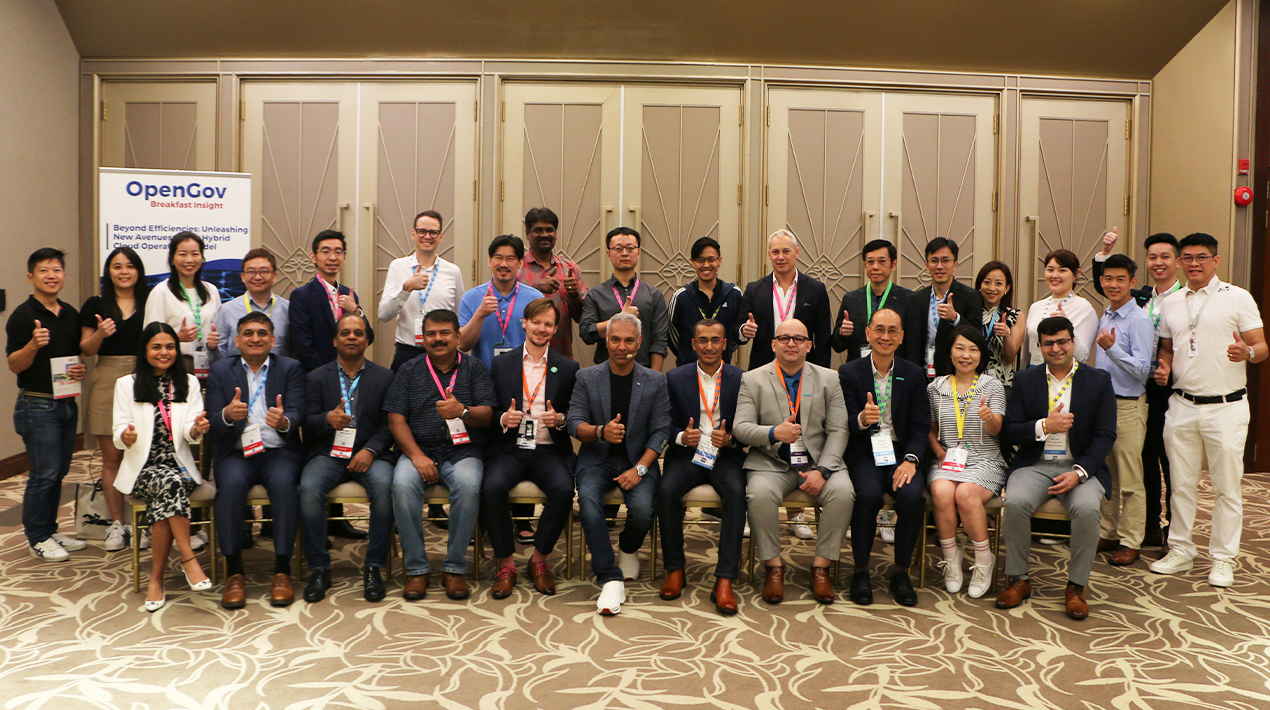
|
Getting your Trinity Audio player ready...
|
In the era of digital transformation, the hybrid cloud has become a crucial driver for organisations striving to navigate and thrive in a rapidly evolving environment. The adoption of advanced technologies such as big data analytics, machine learning, and artificial intelligence empowers businesses to leverage innovation and enhance their decision-making processes. This paradigm shift underscores the importance of hybrid cloud in enabling organisations to adapt to change, drive growth, and remain competitive in today’s dynamic business landscape.
 Executives surveyed by HPE support the idea that a hybrid cloud strategy represents the optimal blend of technologies for achieving their company’s goals. According to their findings, 91% of organisations are currently implementing this operational model to some extent. Among these organisations, 33% utilise a combination of private and public clouds, while 31% leverage a mix of private and public clouds along with on-premises infrastructure.
Executives surveyed by HPE support the idea that a hybrid cloud strategy represents the optimal blend of technologies for achieving their company’s goals. According to their findings, 91% of organisations are currently implementing this operational model to some extent. Among these organisations, 33% utilise a combination of private and public clouds, while 31% leverage a mix of private and public clouds along with on-premises infrastructure.
Global enterprise leaders emphasise that a hybrid cloud approach offers unparalleled flexibility and control, allowing organisations to tailor their operations to suit their specific needs. This approach also facilitates seamless integration, enabling businesses to develop digital products and services with agility and efficiently move data across different environments. These capabilities are instrumental in driving business growth, creating new revenue streams, and facilitating the integration of acquired companies by transitioning their existing legacy on-premises systems into existing cloud components.
Similarly, Singaporean enterprises and organisations have demonstrated a solid commitment to technological advancement by widely adopting cloud strategies. Recognising the importance of flexibility and scalability in today’s digital era, they have embraced hybrid cloud solutions to seamlessly integrate on-premises infrastructure with public and private cloud services, enabling them to optimise their operations.
The strategic objectives driving Singapore’s embrace of hybrid cloud, including enhancing operational efficiency, facilitating digital transformation, and capitalising on emerging opportunities, highlight the importance of a well-defined plan for successful implementation. Without this strategic approach, organisations may find themselves with a fragmented and inefficient hybrid data and cloud environment, failing to realise the full benefits of hybrid cloud adoption.
To avoid this scenario, organisations must adopt a more strategic approach to hybrid cloud and simplify data management. This involves shifting from a hybrid cloud implementation by accident to one by design, thereby enhancing their cloud operating model and maximising the benefits of hybrid cloud adoption.
 Furthermore, security remains a paramount concern in hybrid cloud environments. Organisations and enterprises must assess their risk tolerance, as opting for an exclusive private cloud might seem like the safest choice. However, despite the common belief that private clouds offer the highest level of security, the advantages of a hybrid cloud far outweigh this assumption. It is crucial to understand that the hybrid model is not inherently insecure simply because private clouds are often perceived as more secure.
Furthermore, security remains a paramount concern in hybrid cloud environments. Organisations and enterprises must assess their risk tolerance, as opting for an exclusive private cloud might seem like the safest choice. However, despite the common belief that private clouds offer the highest level of security, the advantages of a hybrid cloud far outweigh this assumption. It is crucial to understand that the hybrid model is not inherently insecure simply because private clouds are often perceived as more secure.
Hybrid cloud affords organisations the flexibility to implement security measures across various layers, including legacy systems, on-premise private clouds, and cloud-based data. This approach enables organisations to implement stricter security measures, outsource to specialised providers, establish secure connections through tunnels, and reduce the time spent on monitoring security subsystems and compliance risks.
Virtual Private Networks (VPNs) can mitigate data compromise risks when transmitting data between legacy systems, on-premises infrastructure, and the cloud. Additionally, a hybrid cloud setup introduces redundancy, enabling organisations to implement backup plans and minimise downtime. Overall, the hybrid cloud model helps reduce risk and allows organisations to concentrate on their core business activities.
The OpenGov Breakfast Insight on 8 March 2024 at Equarius Hotel Singapore has delved into the critical role of hybrid cloud in modern business operations, highlighting its ability to provide flexibility, scalability, and enhanced security. With a focus on practical insights and real-world examples, the event provided delegates with valuable information on how to implement and manage hybrid cloud solutions effectively.
Opening Remarks

According to Mohit Sagar, the CEO and Editor-in-Chief at OpenGov Asia, businesses increasingly turn to hybrid cloud solutions for operational optimisation and competitiveness in the digital age. This architecture combines on-premises infrastructure with public and private cloud services, offering flexibility and scalability and allowing strategic workload, application, and data transfers across environments for enhanced performance and cost-effectiveness.
“Singapore has made significant strides in digital transformation by integrating on-premises infrastructure with public and private cloud services,” Mohit acknowledges. “This strategic approach offers unparalleled flexibility, scalability, and innovation, positioning Singapore at the forefront of technological advancement.”
Adopting a hybrid cloud is both a technical change and a strategic imperative for sustainable growth in the digital era, as exemplified by Singapore’s significant strides in digital transformation.
Businesses in Singapore maximise performance, manage workloads effectively, and balance security and compliance complexities with a hybrid cloud strategy. The hybrid model enables organisations to balance security, compliance, and innovation, supporting confident digital transformation.
“In Singapore, 67% of IT teams used a combination of private and public clouds, multiple public clouds, or on-premises and hosted data centres,” Mohit reveals. “Even with data management and complexity difficulties, more than two-thirds of Singaporean firms utilise a combination of private and public cloud and on-premises and hosted data centres.”
Elaborating on the advantages of a hybrid cloud, highlighting its ability to leverage the strengths of both on-premises and cloud systems, Mohit notes that global enterprise leaders believe that a hybrid cloud gives you the flexibility to operate and better control that suits the organisation better operate and better control that suits the organisation best.
The hybrid cloud allows seamless integration for developing digital products and services with agility, enabling data movement across various environments to foster business growth and generate new revenue streams. This is particularly relevant in scenarios where a company is acquired and it is necessary to migrate its legacy on-premises systems to one of the established cloud components.
Hybrid cloud adoption is seen as a tactical advantage, offering a comprehensive solution that combines flexibility, speed, and cost efficiency for organisations undergoing digital transformation. However, despite these benefits, organisations must also address several challenges.
A major challenge is the complexity of operating a hybrid environment that mixes on-premises infrastructure with public and private cloud services. Integration and interoperability challenges may arise, requiring careful design and implementation.
Another significant concern is the issue of security, which requires strong measures to balance accessibility and data protection. Organisations must establish comprehensive security plans to safeguard data, applications, and communication channels.
Additionally, managing the specialised skills, tools, and complexities of data transport and storage in a hybrid environment may increase costs.
Successfully addressing these challenges is crucial for organisations to realise the full benefits of hybrid cloud adoption.
Nevertheless, Mohit recognises that the hybrid cloud is a transformative force, far more than just a technological tool. It is a catalyst for change, a compass directing enterprises through new landscapes.
“With this in mind let’s create new paths together,” Mohit exhorts the delegates, “Empowered by the revolutionary potential of hybrid cloud solutions, we have the opportunity to shape a future characterised by boundless creativity and possibilities.”
Technology Insight

Dilipkumar B. Khandelwal, Chief Technology Officer for SG/SEA at Hewlett Packard Enterprise, provided insights into the advantages and obstacles associated with hybrid cloud utilisation. He also offered his viewpoint on cloud adoption strategies, effective implementation of hybrid approaches, and methods for tackling governance issues.
Dilipkumar recognises the critical importance of a hybrid cloud in modern business operations. This approach combines the best of both worlds, allowing organisations to leverage the scalability and flexibility of cloud services while maintaining control over sensitive data and applications. By embracing a hybrid cloud, businesses can adapt quickly to changing market conditions, innovate with agility, and drive growth in a rapidly evolving digital landscape.
With a hybrid cloud, businesses can run sensitive workloads in their private cloud and transfer data between suitable public cloud data centres, adapting to regulatory changes and evolving requirements.
Business continuity, crucial for regulatory compliance, is improved with hybrid cloud support for application, data, and disaster recovery tasks, protecting against system failures, security issues, and physical disasters.
For example, a company could duplicate critical workload data from a local application to a public cloud, ensuring availability or recovery in case of data loss. In a more complex scenario, a business might scale or migrate a busy application from its private cloud to the public cloud to manage increased user traffic, preventing performance issues and improving user experience.
Enterprise applications and data resources inherently carry security, performance, and reliability risks. Hybrid clouds provide companies with the flexibility and control to strategically position applications and data according to changing business and technological needs.
Building on this idea, with a hybrid cloud, enterprises can choose the location of applications and data and determine the most effective way to allocate resources and services to achieve optimal outcomes for the business and its application users.
Dilipkumar acknowledged that deploying hybrid clouds can be challenging due to configuration and security complexities. IT staff must manage authentication and security measures for private and public cloud workloads and data, ensuring consistency and complementarity across both realms.
“It is crucial to ensure that security settings are consistent and complementary across both realms, as any change in one cloud may need to be reflected in the other,” Dilipkumar cautions.
In tackling these obstacles, Dilipkumar says that HPE provides unmatched simplicity in deploying hybrid cloud solutions. Referred to as a unified edge-to-cloud platform, HPE offers a streamlined and accessible method for building and overseeing hybrid cloud ecosystems.
It integrates critical features such as flexibility, scalability, security, visibility, and ease of management, allowing organisations to deploy traditional or cloud-native workloads across their entire IT ecosystem.
“In the dynamic digital landscape, the hybrid cloud is pivotal for businesses, offering agility and control,” concludes Dilipkumar. “By simplifying the adoption and management of hybrid cloud strategies, HPE empowers companies to leverage the latest technologies effectively and stay ahead. We support a hybrid-centric strategy.”
In Conversation With
A hybrid cloud is a sophisticated cloud computing system that integrates public and private cloud services to manage a wide range of applications effectively. This environment provides organisations with the flexibility to place their most sensitive workloads in an on-premise cloud (private cloud) while leveraging third-party cloud providers for less critical resources, thus allowing them to harness the advantages of both approaches.
For enterprises seeking greater control and security over their data while also requiring a cost-effective way to scale operations to meet fluctuating demands and support long-term growth, a hybrid cloud emerges as the optimal choice.

Sander Veraar, Vice President of Strategic Services at StarHub, underscored the critical role of cost management in companies contemplating cloud migration. While choosing a private cloud involves substantial fixed costs for owning and managing internal data centres, public cloud services offer a more adaptable cost structure with operational and variable expenses.
“A hybrid cloud environment offers companies the flexibility to store their sensitive business-critical data on their on-site servers while utilising the public cloud for less critical data and applications,” explained Sander.
This setup allows businesses to optimise their infrastructure costs by scaling resources according to demand. During periods of increased demand, companies can avoid significant capital expenditures by paying for the resources they actually use. Conversely, when demand decreases, costs are reduced accordingly.
Sander believes that organisations gain significant resource advantages with a hybrid cloud compared to traditional physical data centres. The hybrid cloud’s ability to efficiently allocate, deploy, and scale resources enables companies to respond to spikes in demand quickly. When demand exceeds the local data centre’s capacity, a company must have the capability to scale up immediately to meet the increase, a capability that a hybrid cloud environment provides effectively.
Sander points out that a swift response not only prevents missing potential customers but also protects the organisation’s brand reputation. A hybrid cloud setup allows companies to scale up applications to the public cloud to meet demand, ensuring extra capacity and scalability.
Organisations can proactively manage evolving security challenges in a hybrid cloud environment by tackling the following critical issues and adopting recommended strategies:
- Visibility Challenges: The integration of public and private clouds can introduce complexity and elevate security risks.
- Insecure Data Transmission: Data transfer between public and private clouds poses security risks, such as eavesdropping or cyberattacks. Robust encryption, including hardware security modules and cryptographic tools, is crucial to secure data in transit.
- Compliance Challenges: Hybrid cloud complexity can challenge compliance efforts. To maintain compliance, prioritise it from the start, conduct continuous security assessments, and follow data security guidelines. Encryption and adherence to standards can also help.
- Supply Chain Vulnerabilities: Small vendors in the supply chain pose major security risks. Attackers may exploit these vulnerabilities to access larger targets. To mitigate this, use strong encryption and strict access control to secure data transfers and reduce hybrid cloud breach risks.
By effectively addressing these challenges and implementing best practices such as robust encryption, continuous security risk assessment, and stringent compliance adherence, organisations can enhance their security posture in a hybrid cloud environment and proactively mitigate emerging security concerns.

Dilipkumar B. Khandelwal, who serves as a Chief Technology Officer SG/SEA, Hewlett Packard Enterprise, explained that Hybrid cloud solutions combine on-premises and public cloud environments, enabling seamless collaboration and data integration across diverse sources. They enhance intelligence through:
Data Warehouse Integration: Combining data from AWS Redshift, Google BigQuery, and Azure Blob Storage into a centralised data warehouse for quicker insights and decision-making.
IoT Connectivity: Connecting IoT devices to a centralised data repository for improved operational efficiency and insights for predictive maintenance.
Machine Learning Model Training: Increasing accuracy and relevance by feeding machine learning models with real-time data from various sources.
Security Analytics: Strengthening security monitoring and incident detection by collecting and analysing log files and event data from multiple sources.
Customer Experience Enrichment: Improving personalisation and satisfaction by creating a comprehensive customer profile from various touchpoints.
These examples showcase how hybrid cloud solutions streamline data integration, leading to actionable insights, increased efficiency, and enhanced intelligence. They promote collaboration and innovation by connecting data sources and breaking down organisational silos.
In managing threat detection and continuous monitoring in a hybrid cloud environment, various strategies are used to mitigate security risks and promptly identify potential breaches. These include:
- Real-Time Threat Detection: Using advanced cloud security monitoring solutions to continuously scan logs and events across the hybrid environment for anomalous activities in near-real-time.
- Multi-Layer Security Approach: Implementing a combination of native cloud monitoring tools, third-party solutions, and best practices to ensure comprehensive coverage of the hybrid cloud infrastructure.
- Cloud Security Information and Event Management (SIEM): Employing an SIEM tool to collect and analyse log data from both physical and virtual servers, aiding in the identification of suspicious behaviour and reducing false positives.
Additionally, employing machine learning algorithms and AI-powered threat detection engines can significantly enhance the identification of sophisticated threats. Collaborating with other organisations and security communities to share threat intelligence can improve defence mechanisms and reduce blind spots.
Applying a zero-trust model, where no entity is implicitly trusted, can help limit the impact of compromised credentials and reduce the likelihood of successful attacks.
“These approaches, coupled with staying abreast of the latest developments in cloud security, enable organisations to defend against the unique challenges of hybrid cloud architectures proactively,” Dilipkumar says.
Closing Remarks
Dilipkumar expressed gratitude to the attendees of the OpenGov Breakfast Insight, acknowledging their dedication to sharing knowledge and fostering professional connections in the digital era.
He views these gatherings not simply as conversations, but as opportunities to exchange valuable experiences and insights essential for navigating the complexities of today’s digital landscape. Dilipkumar is optimistic that these interactions will enable participants to leverage their newfound knowledge in their respective workplaces, promoting innovation and facilitating growth.
Dilipkumar reiterated the benefits of hybrid cloud solutions, which blend public and private cloud services to enhance operational efficiency and flexibility while safeguarding sensitive data. He highlighted their importance in digital transformations to maintain competitiveness and resilience in evolving business environments.
In such circumstances, it becomes evident that businesses can generate significant value for themselves and society at large by embracing technology wisely. He emphasised the necessity of continuous learning and adapting to technological advancements, acknowledging the dynamic nature of the technology sector and the ongoing need for education and evolution.
Furthermore, Dilipkumar encouraged continued collaboration and knowledge sharing among participants to foster a robust business ecosystem. He is convinced that success in the digital era hinges on collective efforts and the sharing of insights and best practices. By working together, businesses can create an innovative and sustainable environment that benefits all stakeholders.
Dilipkumar expressed optimism about the delegates’ potential to drive technological innovation and address challenges in the digital era. He urged them to maintain their commitment to advancing technology and assisting companies and customers in navigating the evolving digital landscape.
“Given your experience and dedication, I am confident that you will continue to play a pivotal role in shaping the technology industry and fostering business sustainability,” Dilipkumar concluded.
















